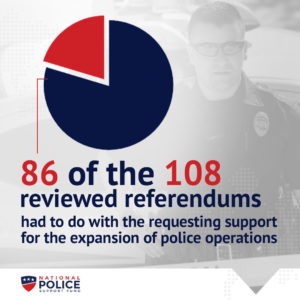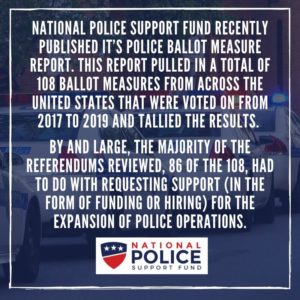2017-2019 Police Ballot Measure Report: What This Data Means
National Police Support Fund recently published it’s Police Ballot Measure Report. This report pulled in a total of 108 ballot measures from across the United States that were voted on from 2017 to 2019 and tallied the results. Here’s what we found.
By and large, the majority of the referendums reviewed, 86 of the 108, had to do with requesting support (in the form of funding or hiring) for the expansion of police operations.
For example, many jurisdictions were requesting funding in order to hire more staff and personnel. Other operational referendums requested funding to upgrade or replace outdated or unsafe facilities.

Why Do Police Departments Need More Funding?
The prevalence of these requests points to one major factor: populations are increasing, and population density is presenting a real challenge to police departments across every region of the country.
In order to properly support a booming population, police departments must have the necessary equipment, facilities, and personnel to be able to do their jobs and provide safety and security for all citizens.
Examples/What Happens if….?
When met with pushback on funding requests, many jurisdictions have no other choice but to cutback and try to effectively consolidate services. In some cases, this scenario played out on the ballots as some operations attempted to disband or consolidate departments in order to save on costs.
For example, voters in Thomaston, Georgia were asked to decide between shutting down the town’s police department and handing duties off to the sheriff’s office, or keeping the police department in operation. This tough predicament was brought about due to a decrease in the number of officers working as well as a difficulty in filling vacant positions. The Thomaston police department often cites lacking family benefits packages as a large contributing factor.
While voters elected not to disband the department, the root issue remains unsolved — officers have voiced concern that family health benefits were not available, which made the job less appealing for those tasked with supporting dependents. Without the proper funding, these benefits cannot be authorized and therefore the department will continue to list without adequate staffing.

Other townships such as the Village of Attica, Ohio voted to discontinue their dedicated police operation instead of approving more funding. In this case, the department was requesting a levy increase that would amount to about $175 per resident each year. Attica is a small community of under a thousand residents, most of whom are elderly and on a fixed income. It’s unsurprising, therefore, that the tax increase was not justifiable — but now, this town is left without proper police services. The territory of the Sheriff’s Department would in this case take over, which provides some protection but perhaps not the strength of a dedicated police force.
In some areas, upgrades are needed in order for police officers to effectively do their jobs. A ballot measure presented to voters in Norwich, Connecticut proposed a $2.7 million upgrade to the radio system used by officers. With the outdated network, officers were experiencing dead zones and dispatch was unable to function properly. This raises major concerns for public safety, and voters acted accordingly to pass the measure. Voter education is important in these scenarios, as is understanding the farther reaching effects that such legislation can have on public safety.
Looking at the big picture, not only the voting results, can bring to light many issues that lie beneath the surface. This is an issue with many ballot measures — a lack of education and understanding of the farther reaching ramifications of a passage or failure. For the Thomaston police officers, life goes on, but little may improve even with the decision to keep their jobs available.
Studying data such as that collected for the purposes of this report can help benefit the growing need to improve police operations and provide the proper support for these jurisdictions to perform their duties safely and efficiently. Often, the story goes much beyond a yes or no vote, and taking the time to understand each of these data points can help shape a better future for our police and law enforcement officers.








